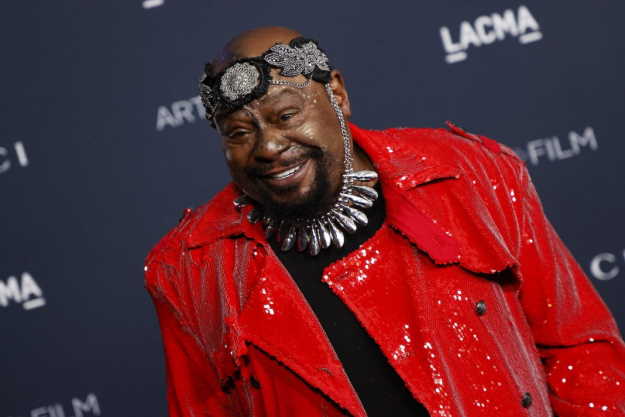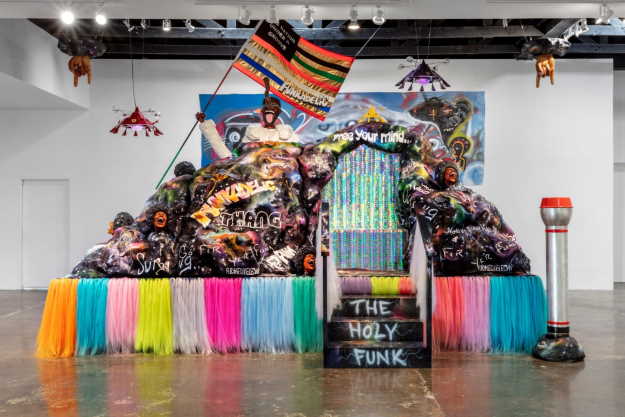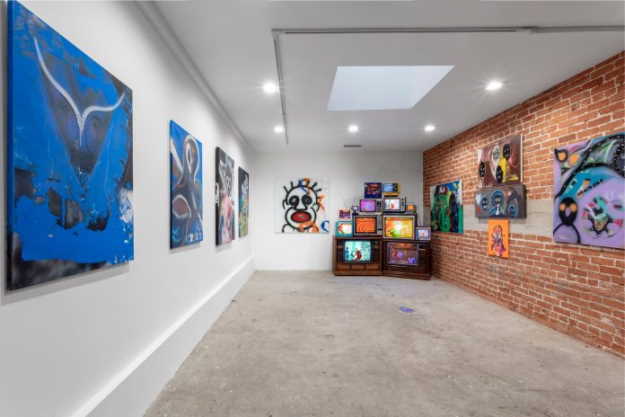|
Taken from Los Angeles Magazine (Dec 16, 2022)
15 Minutes with George Clinton
The octogenarian musician and visual artist is showing a new painting and sculpture exhibition at Jeffrey Deitch in Los Angeles
by Amadour

Musician George Clinton attends the 11th Annual LACMA Art+Film Gala at Los Angeles County Museum of Art on November 5, 2022. (Photo by Michael Tran / AFP) |
Known worldwide as the Godfather of Funk, George Clinton of the music collective Parliament-Funkadelic showcases his breadth of talent in a new painting and sculpture exhibition, The Rhythm of Vision, at Jeffrey Deitch in Los Angeles.
In this interview, Clinton speaks about his tactility with storytelling, how he maneuvers with color, and the many innovative collaborators throughout his lifelong career. On the heels of his art practice, it was recently announced that actor Eddie Murphy will play Clinton in an upcoming biopic on his life. Clearly, Clinton is at the top of his game.
LAMag: The Rhythm of Vision coincides with the 40th anniversary of "Atomic Dog", your number-one record that has influenced musical and visual artists, including Snoop Dogg, Dr. Dre, and Lauren Halsey. How does the image of the dog resonate with you in pictorial language?
Clinton: There is a whole dog "thing" I've been dealing with for years. "Walking The Dog" [by Rufus Thomas and performed memorably by The Rolling Stones] was a song back in the sixties. I got into the "dog" once I got a hit record. I started trying to analyze why I wrote "Atomic Dog". I had one dog in my life as a kid, and he died, and it broke my heart, so I never wanted another pet. But then I started thinking about dogs, hot dogs, best friend dogs, and how we relate to dogs. But at the same time, when you want to call or treat somebody bad, "treat 'em like a dog". That always confused me, those two notions. When I started seeing them do chemical tests on dogs and animals in Detroit, I wanted to make [people] aware. So I did an album called Dope Dogs.
So there are many resonances with the notion of the dog in your life.
I also identify with the Dogons [an indigenous peoples group in Mali], the Dog Star, and the Nommos from the planet Sirius B.
How did you discover the Dogon people?
Before the radio station series [Sirius XM]. I made a song called "Dog Star (Fly On)". I also watched a lot of Star Trek.
Who is your favorite Star Trek character?
I like Q. He was in two or three Star Trek: The Next Generation (TNG) episodes. Q is a character who is like a baby god running around, playing with people's lives.
There is the motif and representation of a spaceship in many of your works. What is your vision of this spaceship, and what does it mean to you?
The Mothership [P-Funk's centerpiece stage prop used in the 1970s] is in the Smithsonian Museum. My theory of bringing the Thumpasorus Peoples or "Ga ga goo ga" from my planet to Earth. The mothership brought us here, the Thumpasorus, to bring the Funk to the Earth. In my paintings, you see entities that I identify with and different makeups of what I think intelligence will look like, the different things that beam in and out of realities or dimensions. We will deal with all these various forms of entities in less than 25 years. I got a lot of feeling a lot of people ain't from this planet already (laughs).
I one hundred percent agree with you (laughs) ...You collaborated with artist Overton Lloyd on your painting Got Dat Demic (2020). Can you tell me more about your collaboration?
Overton Lloyd, Pedro Bell, and Ronald "Stozo" Edwards were the artists who did our album covers over the years. Overton did Parliament's albums, "Sir Nose D'Voidoffunk", "Starchild", and Motor Booty Affair. Pedro Bell did Funkadelic's albums like Cosmic Slop. Ronald did Parliament and The Horny Horns. We always dealt with artists from the beginning when we started doing albums as part of our mythology.
I love the P-Funk mythology.
Overton Lloyd grew up with me and painted for Slash, Sly Stone, Bootsy Collins, James Brown, and myself. That was when we did Parliament-Funkadelic, the mythology of all the characters, Motor Booty, all the characters underwater. Dr. Funkenstein is a character. The art came along with the music to tell the story of all the mythology. It also inspired a lot of black kids like Lauren Halsey.
Halsey created a sculptural stage in this exhibition for you. How did that come about?
On the stage are all the characters from the mythology. Everyone from Sir Nose to the lady from Funkadelic with a maggot brain. Lauren is from Compton, you know, the same as G-funk, Dr. Dre, Ice Cube, and all of those. She's a child of that generation. Afro-futurism was the backdrop to their parents' lives, you know, for the last 50 years. Because we had records out in the sixties, that's the backdrop to the culture.

Courtesy Jeffrey Deitch/photo by Joshua White |
I heard you performed a poem on the stage in the gallery. What kind of poetry?
That was from Dope Dogs. I did the "U.S. Custom Coast Guard Dog". That's part of the album.
Given this exhibition is in Los Angeles, what is your relationship to the city and what does it mean for you to be showing work specifically at Jeffrey Deitch?
First, I'm going to start with Jeffrey. Jeffrey is that guy who knows the art world. He found Basquiat, and everybody said I was lucky to get in touch with him and make this show happen. Los Angeles is like a second home to me. That's where P-Funk came to life. Especially California, with Dre, Cube, Eazy-E, Tupac, and all of the West Coast rappers. So it's only fitting that the music does what it did. And Jeffrey understood what we were doing with the theory, art, costuming, and The Mothership; he helped me explain it to the art world.
You mention Tupac. I grew up in Sausalito, and Tupac is from Marin City. Did you ever record at the Record Plant in Sausalito?
Yeah, I was there, and Tupac and Humpty. I knew them before they were Digital Underground. We recorded at the one in San Francisco too.
This exhibition also happens to be in the building that used to be the legendary Radio Recorders, where Elvis Presley, Jimi Hendrix, and you recorded, amongst others. What was it like then?
I mean, it was a big studio. It was rock and roll when I was recording there. I remember being there with Earth, Wind & Fire. It was undisputed as one of the finest spaces to record.
Looking at the colors you choose in these works, I see a lot of blues and oranges within various lines and structures. How do you choose your colors?
That's funny. (Laughs) Because you know I'm colorblind, right?
No, I didn't know!
Usually, I write the word blue or red on the can or green or whatever and have them in certain places. But that only works sometimes because the kids will come along and change the colors to see if I know what I'm doing.
Can you see any color?
I see light gray, dark gray, black, and white. I can feel the tones and shades, just like dogs. I was a barber at one point. So I know how to fade in more ways than just looking at the colors. I can fade just from the shapes of things and their feeling. I started trying to intellectualize it, writing it down and thinking how do you do this? And it's been fun trying to analyze color [perception]. Overton gave me scales and things to try to see if I could, but nothing happened.
They gave me some glasses that do that, but I don't want them because I can feel the shapes in the tone. It's like the music. I started making music with Motown, which had to be precise and clean. We didn't make it in before Motown was at its peak. By the time we made it, psychedelic was coming into play, and we could do our thing and feel our way through it. So I learned both ways. I learned how to do it right, sloppy and funky. Once psychedelics came in, the noise became music. Feedback became music.
It seems you just had to feel your way through it.
Well, once I started making records like that, I broke all the rules. Maggot Brain is one of my biggest records, and it's just two guitars. As soon as the record comes on, I faded the drums out. So I learned how to do records a whole 'nother way from what is typically the right way, and I perfected it.
First, we were joking, and it became the album Free Your Mind... and Your Ass Will Follow. We were clowning around, but after a while, that became an art form and we got pretty good at doing crazy things. The strokes are your lexicon, and the textures and all are the EQs, echoes, and things. They're the same frame of mind once you get it, especially if you are playing music you like. I got a lot of my copyrights back, and I'm happy. I'm in the frame of mind when I'm stroking, dancing on the canvas, and that's the name of the show; The Rhythm of Vision. Mm-hmm. It's also from one of the lyrics of our songs ["Mr. Wiggles" by Parliament], "and the rhythm of vision is a dancer".

Courtesy Jeffrey Deitch/photo by Joshua White |
I also noticed sculptures like Sir Nose D'Voidoffunk (2022), which is 3-D printed. How was this conceived?
That was 1977. All those were clones. That's when I first learned about DNA and cloning. Sir Nose D'Voidoffunk is one of the clones of Dr. Funkenstein, along with Starchild and a few others.
That's a great way to link the story with the medium. There are also numerous words within these pieces. Where does this text derive?
Well, it is a lot to me. If you notice, there are lots of pieces of paper on there. There are contracts from the different court cases that I was in where people had forged or signed my name. When I didn't think I could get to court, I decided to make the story told through art and clothing.
In a way, it's not forgetting what happened. I'm also looking at your titles. So you have The Butterfly Effect (2022). What is the significance of the butterfly to you?
I painted the butterfly in my backyard, where there are a lot of birdhouses. And then I was on the album with Kendrick Lamar, To Pimp a Butterfly.
Kamasi Washington worked on that album too. I met him at UCLA with his dad and sister.
He was at the show and the gallery. I worked with him, with Flying Lotus. Kendrick told me [Washington's band] is like L.A.'s new version of P-Funk. They're a little jazzy, Thundercat, Washington, all of them.
This body of work has an eclectic mix of figures here. Are they people in your life? Who are they?
They are entities, characters I sense like I'm feeling. They are Afro-Futurism styles, all the DNA of the facial structure traveling inter-dimensionally. Remember, "Beam me up, Scotty?" Do you know when they step off together? Did you bring everything? I always consider the specific things people will go through at any minute. All that stuff is getting ready to happen right now. I mean, people ain't paying too close attention. But what Elon Musk is doing with these robots is wild. I just saw yesterday that San Francisco is releasing robots with the police with guns.
I read that too.
It is so here that people are still thinking about electric cars... all that other stuff is here.
What is your vision for the future?
I wish I could be around for my vision. Like they did with the covered wagons going west, we are getting ready to go up and out into space. They will be hitting for their margin in five years, and that's just the beginning. Once they do it, they'll have their little gas stations and recharge stations. We are going to be out of here. My grandkids are going live to see all of that.
|